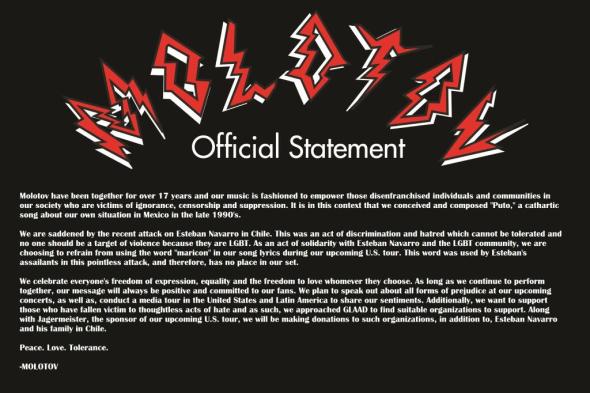You Need Help: Coming Out as Non-Binary at Work
Welcome to You Need Help! Where you’ve got a problem and yo, we solve it. Or we at least try.
Q:
On my paperwork for my new job, I selected the ‘gender non-conforming’ option, which is a legally recognized gender in the state of NY, where I work and live. Everyone I work with is very nice, and it is a very LGBTQ friendly environment. However, I think no one read my paperwork and everyone keeps referring to me as ‘she.’ I keep wanting to correct them but I’m not sure how to do so in a way that will be the most productive and the least awkward (pt. 1 of my question), and I’m also not sure what the best way to point out their error in not reading my paperwork would be, which is important to me mostly in that I don’t want this to happen to someone else (pt. 2 of my question). Although everyone is really sweet, I’m nervous that a) some/all of the people I work with will literally not know what ‘non-binary’ means, b) they will feel distanced/uncomfortable with and around me post me coming out, and c) that they will continue to ask me questions about it/treat me like a encyclopedia long after the initial conversation. While I don’t necessarily mind question-asking, I want to feel like a person at work and not like a giant question mark. What do I do?
-Non-binary worried human
A:
Dear NBWH,
It’s like you are describing a part of my heart years ago. You are talking about a scenario I’ve been in quite a few times now. In fact, I have been in some version of it everytime I start a new job. So, hi, thank you for submitting that question and getting me to think about this in detail. The way I see it, there are four parts to your question. One of them is about how we feel: how we own our identity as non-binary folks. And the other three are strategic: how we engage with the world as out non-binary folks. Let’s start with the feelings part:
How do I as a non-binary person own my identity unapologetically?* There is no silver bullet for this question, and quite honestly my answer changes on the regular. Yet, it is a question I want you to think about. I noticed you doing something I used to do: affirming that everyone is good and sweet while simultaneously being mortified at the thought of inconveniencing these good and sweet people. So, hold this close to your heart as we move forward: any discomfort someone might feel because you are asking for your identity to be acknowledged is their problem, not yours. I’m saying that because I know many of us sometimes hesitate to come out about our non-binary gender because we have done a really good job at internalizing that our gender is a burden (for review, check your a, b, and c points). We often forget that — outside of keeping ourselves safe — people’s reactions are not for us to manage, and that our gender is not for them to process at us. If people are truly kind, then they’ll find a way to process their feelings without encroaching into our emotional wellbeing.
With that in mind, let’s get into strategies:
How to correct coworkers when they misgender us. Bonus points for low awkwardness.
I understand the personal benefit of low awkwardness, and so I want to emphasize that the least awkward way to correct someone is whichever way you feel most comfortable with. We can’t control how they will react, but we can control how we show up for ourselves. I suggest you practice with a friend, to get a feel of what approach feels best for you. Below are my suggestions, according to the setting.
Via Email:
I like to reply to the content in question first and add at the end “Please note that my pronouns are they/them, not she/her.” If the issue persists, I include the same sentence again and make it bold. Now, I know you described your co-workers as nice, but should the situation continue I would recommend raising it to your supervisor in person and then confirming you had that conversation via email. In the worst case scenario this can provide you with proof that you are doing your due diligence, and that whichever coworker insists on misgendering you is creating a hostile environment.
In person:
Now, if you are being misgendered during a conversation, there are a couple of approaches you can take. If it’s a group conversation, you can wait until folks have dispersed to approach a particular colleague in private. You can explain you heard them use she/her when referring to you, and that those are not your pronouns.
For a more immediate approach, and whether it is a group conversation or just a one-on-one, you can say “I just heard you say ‘she’ when referring to me. Those are not my pronouns. I go by ‘they/them.’” You can wait for the person to finish speaking to say your part, or you can just interrupt them to say it. It is 100% okay to interrupt someone when you are not being treated with respect (intentionally or not), and let’s remember that misgendering someone is disrespecting someone. To be clear, my tone is generally amicable in these situations, but it will be more matter-of-fact if the person is a repeat offender.
I also like to model a sentence for these interventions to really drive the point home. After either of the interventions above, I like to add “so if you talk about me, you can say ‘Araguaney is our new hire, they are a kind person, I’m excited to get to know them.’” The content of the sentence is somewhat irrelevant, I just like to make sure to use at least two forms of my pronouns to solidify the example.
For opening lines, if you are approaching someone in private either to share your pronouns or to check in as to why they are not using your pronouns, consider saying “do you have a moment? I want to talk to you about my pronouns.” I encourage you to avoid saying “I’m sorry” because there is nothing for you to apologize about in this situation. You are just showing up for yourself and to help your colleagues get to know you and treat you better. I’m sure you would want them to do the same, if the tables were turned. The opening line above is professional, transparent, and not making a bigger deal of something that should be a totally normal thing. Modeling how normal it could be to check in about pronouns is one way to improve the organizational culture for all, too!
Lastly, you can just interrupt and say “they” the second someone says “she.” I recommend this with folks that already know your pronouns. I do it consistently with people who are “getting used to it” and most times it will cue people to their mistake, so they correct themselves and continue. Barely any interruption and I don’t have to either check out of the conversation or go on with the rest of the conversation hurting quite a bit inside.
In summary: take what works for you from the examples above, find a friend to practice with, and remember that asking people to use your pronouns is nothing to be ashamed about.
How to improve HR practices to be trans-inclusive
So you want your HR department to have and follow a clear protocol around checking for gender markers. Meaning, you want to create institutional change — YES! I am all about that. In fact, I am aggressively all about it. Institutional change matters because we are doing our part in making things easier for the next person, and so the change remains even if we choose to leave the organization. But you already knew that, so how should you go about it?
At one of my previous jobs, I helped institutionalize including our pronouns in our signatures, among other things. For the pronouns in signatures, I first checked in with HR about their current protocol. I suggest you do the same. Perhaps they have a comprehensive protocol in place already, but they have failed to practice it. Brainstorm with them how to avoid that next time. I would also talk to friends and colleagues to get more ideas for it.
I suspect they have a protocol in place but they don’t know to ask for pronouns alongside (or instead of) gender. “Gender non-conforming” can mean a myriad of things, so for them not to ask about pronouns gives me pause — after all, GNC folks can and do use pronouns other than they/them, so clarifying pronouns would be essential here. Ask them directly how they go about pronouns, their response will probably give you an idea for the next step necessary here. I have worked for many well-intentioned HR departments that truly just didn’t know the first thing about trans identities, so a bit of probing will give you more clarity about where they need to improve. If you encounter any resistance, I’d suggest reminding them that having a working system in place will make their jobs more efficient and save them future conversations like the ones you are having right now.
How to have people be normal and chill about us being non-binary
Ah, yes. Some people will indeed not know what non-binary means, some might be weird as hell once you come out, and some will take the path to hell paved with good intentions and an endless amount of questions. The important thing to remember here is that you, precious non-binary babe, have no control over how other people react or feel. What you do have control over is your own boundaries. It is not your responsibility to shrink your identity, or your comfort, on behalf of theirs.
This holds even if one of your colleagues decides to use the angle that they “knew you as ‘she’ for so long it’s hard to switch.” Not only does that angle minimize the respect you deserve, it is also particularly wrong because those were never your pronouns at this job anyway. Still, were that to come up, consider sharing with them a piece I wrote for My Kid Is Gay to support a parent in changing the pronouns they use for their child, which has some 101 guidelines that would be relevant for your coworker, as well.
To your point, if you are concerned that people won’t know what non-binary means, come up with a definition that fits you, and have it ready to share. I just joined a very cis-hetero gym and about a week ago I finally had a chance to come out as genderqueer to my straight, cis guy gym instructor. I mentioned it in passing, he immediately asked “What does that mean?” and for simplicity’s sake I said “I don’t identify as a boy or a girl” to which he replied “Oh, so you are just you.” Of course, my answer is more complicated than that, but this was enough to have him understand the basics. To be honest, his reply surprised me, and I so hope your coworkers’ replies surprise you, too. At one of my jobs, one of my coworkers (a cis woman) didn’t know what non-binary meant, but searched for it online and later sent me an email “Just hoping to confirm these are reputable sources.” Another awesome reply. People know the internet exists, you won’t leave them high and dry if you suggest they do some reading online. If it feels best to you, you can even prepare for these conversations by having some handy links at hand you can refer them to: Everyone Is Gay’s definition of non-binary, or EveryDay Feminism’s article on non-binary trans allyship are both good places to start.
Sometimes I like to give permission to colleagues to ask me questions. This only happens when they are folks I feel have a good grasp of my boundaries, and won’t take it personally if I don’t want to answer one of their questions for any reason whatsoever. Set the boundaries that feel good to you, and remember it is 100% okay to adjust them as you go along.
Regardless of how things go with your colleagues and your HR department, I would encourage your team, supervisor, or HR department to hire a trans facilitator to provide a trans-competency workshop. The workshops can be tailored to their needs, so if they are beyond the basics (which I am not convinced they are), they would still get further in their capacity to hire and retain trans employees. If you have no idea where to start, please feel free to reach me via email and I can give you a couple of names of people in NY.
Finally, if you are still feeling hesitant about creating discomfort in your office, I hope you remember this: discomfort is the gap between what we know and what we need to learn. If any of your co-workers reacts with discomfort, that goes to show they have some room to grow. Their discomfort is not your fault, it is the fault of the lack of education we have about gender diversity in what we call the US. Our gender is not a burden, the binary mainstream society is. You are wonderful, I’m so proud of you for reaching out. Take what works from my suggestions, and know I’ll be hoping it all turns out for the best.
*I’d be remiss not to mention that gender assigned at birth (camab/cafab), ability, race, class, body size, and other identities that inform how much people take us at our word complicate this question in one million ways.
Trans Lifeline, Suicide Hotline Staffed by Trans People, Is Here For You

“If you are not sure whether you should call or not, then please call.”
Trans Lifeline is the first crisis and suicide hotline dedicated to the wellbeing of transgender people, and it already started taking calls just at the end of last year. Greta Martela and her partner Nina Chaubal started it “on a whim on a Sunday afternoon” in September. Nina works on the technical aspects of the hotline while Greta gets the word out about it. Trans Lifeline (877-565-8860) is staffed exclusively by transgender volunteers who are there to support transgender callers, and welcomes genderqueer, questioning and otherwise gender non-conforming folks as well. I was lucky enough to speak with Greta over the phone, and she made it clear that Trans Lifeline also welcomes calls from all folks — parents, friends and partners regardless of gender — who are looking for a resource to support a trans loved one.
Many of us have been reminded yet again of the urgent need for such a resource by the recent passing of Leelah Alcorn, the transgender girl from Ohio who died by suicide on December 28th. The prevalence of suicide attempts among transgender and gender non-conforming adults is 41%, according to the National Transgender Discrimination Survey as reported by the American Foundation for Suicide Prevention and the Williams Institute, UCLA School of Law. This is a staggering fact on its own, and even more so in comparison to the prevalence of suicide attempts among the overall U.S. population (4.6%), and lesbian, gay and bisexual adults (10-20%). In one way, it is incredible that something like this didn’t exist before. In another way, it is all too regrettable that something like this is so dearly needed.
As all brilliant, thoughtful entrepreneurial projects go, Trans Lifeline is currently running a GoFundMe campaign to fund the hotline itself while they wait to be officially approved as a 501c3 (non-profit) organization. In addition, they hope to use the funds to run a large outreach campaign “to make sure that [their] toll free number is readily available to trans people everywhere.”
It’s important to note crisis and suicide hotlines are available for people who are suicidal, struggling with self-harm, and also their friends and loved ones. Anyone touched by suicide or self-harm can call a crisis or hotline for support. In this case, Trans Lifeline is there for trans people and their loved ones.
If you are concerned about privacy, I’m happy to tell you that calls to Trans Lifeline are routed through their answering service, and as such remain completely anonymous. In addition, if you’re nervous or curious about who might answer your call, you can go to their website and check the column on the right to check who is on call. The line covers the United States (877-565-8860) and Canada (877-330-6366), and while it is based in San Francisco, their volunteers live all over the US.
Trans Lifeline
US: 877-565-8860
Canada: 877-330-6366
Playlist: One More Time Without Feeling
feature image via shutterstock
Let me give you a little background on the concept for this playlist. Phil Kaye, a very talented poet, has a piece called “Repetition” where he tells us his mom taught him that “if you repeat something enough times, it loses its meaning.” That’s where this playlist comes in.
Lovingly crafted, this is a playlist that goes through the valleys and peaks & valleys and peaks again that queers might experience in a true to the bone on-and-off relationship. There’s a surprising amount of upbeat songs out there that are written by pretty heartbroken people, folks. Here’s a collection of those songs, in case dancing, singing, and a roller-coaster of emotions play a part in the way you process the end of a relationship, too.

My dog, Tango, while listening to the playlist for the first time.
A celebration of the good and the bad, play this list over, and over, and over again if you’re hoping for the longing to lose its meaning. And by longing I mean that Magnetic Zeros song smacked right in the heart of it.
Nobody to Love – Sigma
Stars – The XX
Rather Be (feat. Jess Glynne) – Clean Bandit
Boats & Birds – Gregory and The Hawk
Waves – Mr. Probz
Monday Morning – Melanie Fiona
La Familia – Mirah
Baby Come Home – Scissor Sisters
Crazy – Kat Dahila
Say You’ll Be There – MØ
Give Up – FKA twigs
I Don’t Want To Get Over You – The Magnetic Fields
I Eat Dinner (When the Hunger’s Gone) – Rufus Wainwright & Emmylou Harris
Fuck Was I – Jenny Owen Youngs
Call It Off – Tegan & Sara
You Don’t Love Me (No, No, No) – Dawn Penn
Dust Clears (feat. Noonie Bao) – Clean Bandit
Young Blood – The Naked and Famous
Want to suggest a playlist theme? Hit Stef up and someone on the team might make it for you.
Get Baked: Triple Threat Vegan Cheesecake
Sometimes I get scared by all the descriptors before a dessert. Some other times I remember lactose and gluten are the Regina George of ingredients to my belly.

on wednesdays we wear pink
After seeing Carolyn’s dairy-free apple cake from heaven (which I made with GF flour and loved and consumed within hours), I set off to record my own little piece of delicious gluten-free, dairy free paradise. Also, Carolyn requested it in all caps and I couldn’t say no to that.
What I love about this recipe is that if you don’t like the cheesecake concept you can just make the filling and use it however you want. When I’m feeling like a cheesecake has three too many steps, I make the filling and use it as fruit dip, or as the substitute to my granola with yogurt snack in the afternoon. Also, you can personalize the whole thing to your taste. I made this a layered vanilla with half strawberry and half vegan chocolate ganache to show you all the tricks at once.
Fear not, I made this in the kitchen of my new place, which means I made it using only the assorted glassware that survived the move, a Talenti Gelato container, a silver spoon and a borrowed Ninja blender. If I and my untested kitchen skills could make it to impress someone in my book club, so can you.

food and books are the way to my heart
Ingredients:
For the crust:
3/4 cup dried shredded unsweetened coconut
9 Pitted dates
1 cup Raw almonds
For the filling:
2 1/2 cups raw cashews (soaked for at least 8 hours, trust me on this)
2 tsps vanilla
1/2 cup olive oil
1/2 cup sugar
Splash of lemon juice
For the strawberry half (optional):
4 strawberries
For the chocolate ganache (optional, but why wouldn’t you?):
2 cups chocolate chips
~2/3 cup coconut milk

almonds, coconut and dates sitting in a tree
Directions:
1. Sprinkle 1/4 cup of the coconut on the springform pan — or not, I like the little coconut shreds. Place the rest of the dried coconut, dates and almonds in a food processor and just go at it until it all looks evenly chopped. Chunky crust will take less chopping than a finer one, so chop the mix for longer if you’d like it to be smoother. The consistency of this crust is going to be crumbly, add more dates to the mix if you’d like it to be a little less so. Place the mix on the springform pan and pat it down evenly.
2. Place cashews in a food processor and puree them. Add the lemon juice, vanilla, olive oil and sugar to the cashews. Blend it all together. You want the mix to be as smooth as possible — this will take a few minutes, so I used the time to wash some of the bowls where I had all the ingredients a second ago.
3. Once the filling is all mixed and smooth, pour only about 2/3 of the mix onto the crust. Even it out with a spatula or a spoon if you have as many utensils as I have. Place it in the freezer for about 15 min. Add strawberries to the remaining filling and blend it all. Pour it in a glass container to keep and wash the food processor immediately.
4. Make the chocolate ganache. Take 1 1/2 cups of the chocolate chips and pour enough coconut milk until to cover. Just like with the chocolate coating for that matzo recipe, go ahead and melt it all together in a double boiler. Once everything is melted and combined, set it aside and add the rest of the chocolate chips to temper it. Keep stirring until the rest of the chocolate chips are melted.
- springform pan
- delicious coconut shreds
- i evened this out with my own hands
- vanilla layer brought to you by my silver spoon
- success!
Now for the triple threat part:
1. Set the strawberry filling and the chocolate ganache next to each other. Take the cake from the freezer and lean it towards a side while you pour the strawberry mix, trying to keep it towards one half of the cake. As you set the cake down, start pouring the chocolate ganache on the other half; it will push against the strawberry portion and even out with the help of your handy spoon.
2. Put the cake in the fridge and let it sit for about an hour before serving. The strawberry part will keep best if frozen; freeze the cake for an hour for prettier presentation. Just run a knife under warm water when you’re ready to serve it, it’ll make cutting the cake 10x easier. Just choose freezer or fridge according to your preferred texture.
Tips & Substitutions I’ve tried before:
– You can substitute olive oil with melted coconut oil. Most recipes call for coconut oil, I just happened to be out of it and olive oil worked just as well.
– You can substitute coconut milk with almond milk creamer and the almonds for the crust with any other hard nut, like macadamia or pecans.
– For an actual raw vanilla version, just substitute sugar with agave or raw honey.
– If you/your roommates/the person you have a crush on have a Vita-Mix, go get it (yes, I just gave you an excuse reason to text your crush).
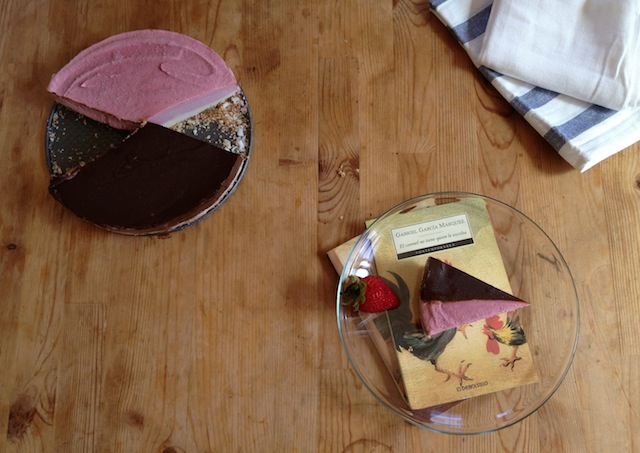
i totally ate a slice before i remembered i had to photograph it
Domestic Work Is Real Work: Nicaraguan Co-Ops Stop Being Polite and Start Paying Women
It is one of the world’s most unfortunate dynamics that domestic labor is by and large considered to only have economic value when performed for families other than our own. Luckily, a handful of co-operatives in Nicaragua have taken steps to change that.
According to the New Internationalist, the Juan Francisco Paz Silva co-op in Nicaragua has included the value of women’s domestic work in their production budget since 2008. Co-op leaders understand that women’s domestic labor contributes to the success of the production process, even if it’s not a “job” assigned by a specific employer with a paycheck. Domestic work is a job in and of itself. The Silva co-op worked with Ético, an ethical trading and investment company, to account for women’s domestic labor in the cost of the co-op’s production of sesame oil. Using the same rate paid for rural male manual labor, a fee of 960 córdobas (around $50) was added to each manzana (0.7 of a hectare) of sesame crop. This added cost continues to be included in the co-op’s Fair Trade contract with The Body Shop.
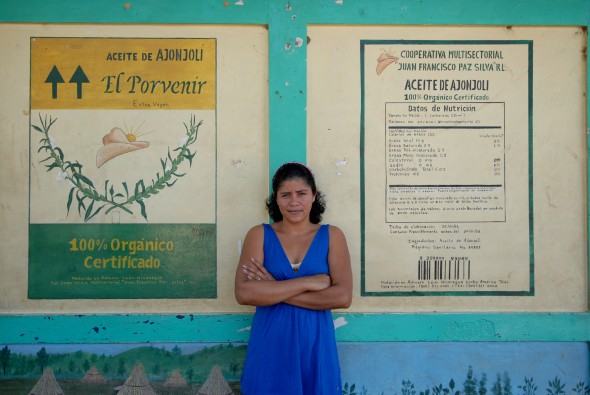
via newint
Valuing domestic work is all about following the production chain all the way to the bottom (and forgetting about the patriarchy). Eva Pineda, gender equity officer for Aldea Global, explains that the chain of events that result in the coffee crops being harvested begins at the farmer’s home. Pineda works for the Asociación Aldea Global Jinotega de Nicaragua, a local co-operative that created and sells Tierra Madre coffee, coffee exclusively produced by Nicaraguan women who own the land they harvest. In a four part video series for Intermón Oxfam, Pineda explains that women’s work days in rural Nicaragua are longer than most men’s work days in the field, yet women remain largely unpaid for their work. Women are responsible for preparing the food, laundry, taking care of the family, the livestock and the home. Their day starts at 4am and can end anywhere between 6 to 10pm -during peak harvest season women usually don’t sleep more than 4 hours a night, regardless of whether or not they are working in the fields. Women’s domestic work is the starting point in the process that results in harvested coffee beans, as they facilitate all the components that allow for the day to run its course. Any feminist would agree, but society still has a hard time remembering not to take that work for granted.
Pineda sheds light on the structure that benefits from women’s unpaid labor. In part 2 of her video series, Pineda explains that women in rural Nicaragua are taught to stay at home and learn how to take care of the family, while men are encouraged to leave their communities in search of better opportunities. The reasoning behind this is that women are fragile and men are not — their definition of fragile becomes clear when she elaborates that a family’s biggest fear is that the woman will come back pregnant, noting that men in general are never really advised against getting a women pregnant when they leave their communities. Because of the expectation to have girls grow up around and take care of their families, many of them are denied education. The lack of opportunities — particularly education — usually dictates a life of financial dependance on a male figure, be it a father or a husband. Paid domestic labor upsets that structure, gives women more power in the community and over their own lives. The effect of accounting for domestic labor in the cost of sesame oil and coffee production goes beyond the tangible monetary amount; it sends the message that women’s work is valuable no matter what it looks like or where it takes place in the production process.

eva pineda via intermon oxfam
“You no longer have to lower your head and wait for the man to tell you what to do; now we make our own decisions and share activities and responsibilities with our partners.” – Adilia Amador Sevilla from Achuapa, Nicaragua
To be clear, the added income does not go directly into the women’s hands. A study presented at the Oñati International Institute for the Sociology of Law clarifies that the co-ops have used the fee paid for women’s domestic labor to set up general savings that now finance a micro-loan program for women members of the co-op. Women have used the micro-loans to support their own artisan work and the preparation of goods that can be later sold at the co-op shop. As a result, the Silva co-op has seen an increase in the amount of women that have joined the cooperative as full members. In 2010, 19 of the 34 new members were women — a significant increase for a co-op that previously had only 42 women out of 272 members. Aldea Global uses the gender premium added to their products to support the co-op’s gender equity program, which funds the women’s rights awareness workshops for men and women. The gender equity program also covers the legal costs necessary to change farms’ and lands’ registry to include the name of the women working in them.

luz evelia godines, member of aldea global. via intermon oxfam
Pineda mentions land ownership and acknowledgement of the key role domestic work has in the production process has opened women’s eyes. “They had never seen themselves as part of the production process, just as unpaid cooks for their husbands” but now they have more confidence and a well-deserved sense of ownership.
The impact of these initiatives is the more striking because of its limited execution -I couldn’t find any other similar initiatives taking place anywhere else in the world. Yet again, recognizing domestic labor as valuable challenges the structure that dictates only men should control the means of production. Saying labor is valuable even when it is: a) predominantly performed by women and b) performed outside the workplace would mean recognizing women as equals. (Not to mention the intersection between women of color and domestic work.) Here’s hoping one day that takes place.
Team Pick: “All About Anal” Video Series
feature peach image via the csph
Dani and Ali’s Team Pick:
Did you know August is Anal Sex Month? Well, now you do, and it’s not too late to celebrate! The Center for Sexual Pleasure and Health (CSPH) has your back. Megan Andelloux, Certified Sex Educator and founder of the CSPH, answered the three most common questions in “All About Anal,” a three part video series on anal play.
Before we go any further, it’s important to note that a team member who shall remain nameless emailed this out as a gift to us. Because she thought these videos would make our collective sex-nerd heart sing. And they did. Our hearts sang, our souls fluttered and our rectums…chortled?
Anybutthole.
Ever wonder how to get a sparkly clean asshole and rectum, ready for play? Megan shares body safe, sex- and body-positive tips in under three minutes. She also covers the super common concern of what happens if you feel like you need to poop during anal and what exactly makes a toy anal safe. In just under ten minutes of watching time you can get the basics for the bum explained in a body inclusive, super enthusiastic language.
What we like about these videos is not only the accurate, clear info about all things butt, but also their super approachable, casual tone. No muss, no fuss, just butts. They are definitely a conversation starter if the butt is something you’d like to explore with a partner and have no idea how to bring it up. And butts can super fun to play with! Take it from us.
So without any further anal ado, here are all three videos. Headphones recommended in mixed company. Bottoms up!
“I’m concerned about poop during anal play. What can I do?”
“How do I clean my ass for anal play?”
“What type of toys would you recommend for anal play?”
American Bar Association Confirms Neither “Gay Panic” Nor “Trans Panic” Are Excuses for Murder
On Monday, the American Bar Association (ABA) voted in favor of Resolution 113A, which calls for federal and state lawmakers in the U.S. to restrict the “gay panic” and “trans panic” defenses.
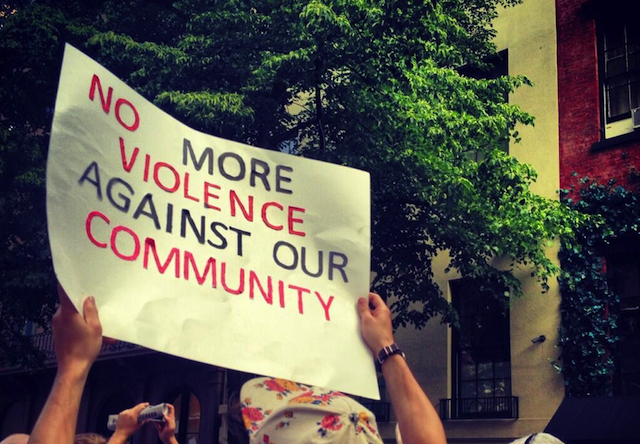
via twitter
The “gay panic” defense has an unfortunately long and well recorded history in American courtrooms. While reporting on 15-year-old Larry King’s murder, we mentioned how “gay panic” has been used in defense of Jonathan Schmitz, Joseph Mitchell Parsons and Matthew Shephard’s attackers. Brandon McInerney, the classmate who shot and killed King, also attempted to use the “gay panic” defense before he eventually pleaded guilty to second degree murder and voluntary manslaughter.
“Gay panic” has been most commonly used to claim that unwanted sexual advances from gay men naturally provoke heterosexual men to commit murder, and that they therefore cannot be held responsible for violence in those cases. “Trans panic” follows the same warped logic and has been used in cases where heterosexual men claim a woman’s trans* history or identity (especially if they felt it wasn’t clearly disclosed enough before engaging in sexual activity) “threatened their sexuality and self-image” to the point of committing murder. The “gay/trans panic” defense argues that it is the victim’s identity, and not the perpetrator’s bigotry, that is at fault for the crime — this is victim-blaming in action and institutionalized. The defense is based on the idea that, based on heteronormativity and cisnormativity, someone’s LGBT identity can be so shocking as to send an otherwise reasonable person into a state of temporary insanity characterized by unusual violence. This defense is not officially considered a legal defense — it’s just a bigot’s way of going for a “temporary insanity” or “diminished capacity” angle.
It is quite noteworthy that a concept which excuses violence as a response to unwanted sexual advances has been historically used to defend heterosexual, cisgender men.
In 2006, California became the first state to limit the use of the “gay panic” defense in criminal trials. The state revised jury instruction to ensure jurors understood they had a duty to “operate free from bias” and that “a defendant’s prejudice against his victim cannot affect their deliberations.” This measure came as a response to the 2002 murder of Gwen Araujo, where the men who beat and choked her to death claimed to have been blinded by rage after learning she was a trans woman. Jury instruction in California now covers the fact that “gay panic” defense contradicts state laws that protect LGBT people from discrimination.

via nothing-is-new
The ABA Resolution 113A, which was unanimously passed by the ABA House of Delegates, encourages lawmakers to follow in the steps of California. The resolution urges for “legislative action to curtail the availability and effectiveness of the “gay panic” and “trans panic” defenses,” including:
a) Requiring courts in any criminal trial or proceeding, upon the request of a party, to instruct the jury not to let bias, sympathy, prejudice, or public opinion influence its decision about the victims, witnesses, or defendants based upon sexual orientation or gender identity; and
b) Specifying that neither a non-violent sexual advance, nor the discovery of a person’s sex or gender identity, constitutes legally adequate provocation to mitigate the crime of murder to manslaughter, or to mitigate the severity of any non-capital crime.
ABA President Laurel Bellows explains that this measure “gives the lawyers facing [the “gay panic” defense] the power of the ABA to indicate we don’t believe this is a viable defense.” The measure has immediate relevance as the “gay panic” defense is currently being used in the murder case of Marco McMillian, an openly gay mayoral candidate in Mississippi found dead earlier this year.
While ABA’s official rejection of the “gay/trans panic” defense is particularly relevant to those in the legal field, one hopes their stance will carry a message that goes beyond the courtroom. D’Arcy Kermnitz, executive director of the National LGBT Bar Association, explained this defense represents “the notion that LGBT lives are worth less than other lives.” After reading through transphobic and homophobic media reports that blame a victim for their own murder, it’s always encouraging to learn that more people and institutions in the U.S. are willing to call bullshit on homophobia, transphobia and victim blaming all at once.
Gay Liberation Front Manifesto: Still Revolutionary 30 Years Later
Sometimes I sit and read things on the internet with that rushed feeling I got when I was falling behind in my Women’s Studies class coursework. This holds particularly true for anything related to queer history — it’s like a never-ending game of catch up where I’m trying to put all the pieces together of this map. I mean, if we don’t know what got us here, how will we move forward? Peter Tatchell seems to share that feeling. He wrote about how the Gay Liberation Front Manifesto changed him as an activist. It wasn’t until I read his piece that I realized I had never actually read the manifesto itself.
The Gay Liberation Front Manifesto was published by the London-based Gay Liberation Front (GLF) in 1971. The manifesto encourages us to identify and challenge the insidious ways in which oppressive attitudes permeate our relationship with others and our understanding of self. The manifesto outlines how the nuclear family, formal education, media, workplace, public policies and the mental health field function as spaces where rigid gender norms, sexism and homophobia are sold to us as markers of ‘normalcy.’ Although sometimes simplistic to a fault, the manifesto provides us with a solid, basic guide on how the patriarchy benefits a selected few that become invested in replicating its systems of oppression as a means of maintaining the status quo. At some point I started picturing the patriarchy as Agent Smith from The Matrix, but I digress.
The manifesto places the LGBT struggle within the greater anti-capitalist, anti-imperialist movement. It explains our oppression as a consequence of sexism and how capitalism is interested in maintaining the false need for gender roles. In a society that is “founded upon the sanctity of the family, the right to property, and the worthwhileness of ‘getting ahead,'” there is a high value placed on reproductive sex, which commodifies women for their ability to carry a child. Gender norms ensure “property acquisition and worldly success” remain masculine traits. As such, the GLFM proposes that the abolition of the nuclear (heterosexual) family as the ideal would debase most arguments against LGBT equality and raise each of our diverse, wonky, loving, inexplicable families to the same level.
The Gay Liberation Front Manifesto is not alone. Indeed, the anti-capitalist, anti-imperialist sentiment is echoed in Sexo y Revolución by el Frente de Liberación Homosexual — the Gay Liberation Front in Argentina. In Sexo y Revolución, a zine-manifesto hybrid published in 1973, el Frente explores the reasons behind why as a group we are willing to accept and even defend the oppression we are placed under. Like the GLF manifesto, it concludes that capitalism ensures its continuity by permeating into all areas of society so as to prevent the individual from stepping out of and questioning the system. It also concludes that gender roles must be subverted, but centers the idea around sexual pleasure as currency for liberation.
Sexo y Revolución builds upon the ideas suggested by the GLFM and presses further on the individual level. Because the personal is political, el sexo mismo es una cuestión política. The nuclear heterosexual family will pervade as long as sex continues to be thought of only as it relates to reproduction. As long as sex is considered solely a means of reproduction, then queers can be freely labeled as deviants. Sexo y Revolución explains then that queer oppression is a result of the threat of sex as an act of pleasure and not reproduction, which denies the role of the active male and passive female as taught by gender norms. We are the scapegoats of sexual repression. Our liberation will not be real unless it takes place along personal and ideological lines as well as economic and political.
Both texts also highlight the shared plight of the LGBT struggle and feminist groups. In a call for an alliance with feminist groups, the GLF Manifesto remarks on the need for gay men to surrender the “degree of male chauvinism and male privilege that they still all possess.” Their attempts at acknowledging the importance of intersectionality, while commendable, are glaringly flawed. While both manifestos read as surprisingly non-exclusionary of any LGBT identity, I do wish their language wouldn’t feel as if spoken by predominantly cisgender white people by default. Non-exclusion will never equal intentional, explicit inclusion. I mean, at the bare minimum, racism is also a thing that oppresses LGBT people and feeds the capitalist machine.
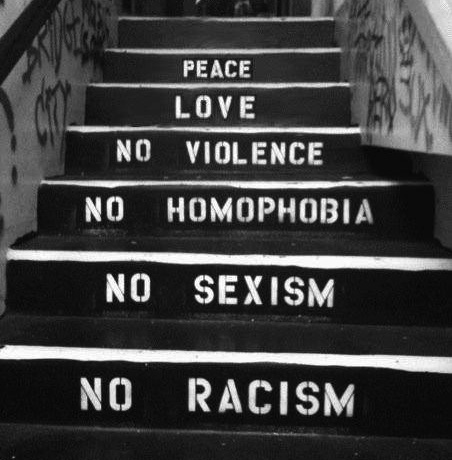
the basics via weheartit
There is no evidence, beyond their shared name, that the Gay Liberation Front and el Frente de Liberación Homosexual collaborated on these pieces. It is remarkable then that they mirrored each other’s main ideals so clearly, ideals that remain radical to this day in their rejection of assimilation into the heterosexual standard as prescribed by the mainstream. After the publication of the manifesto, the Gay Liberation Front went on to execute high-profile protests, most notably their disruption of the launch of the morality campaign, Festival of Light. El Frente de Liberación Homosexual, on the other hand, faced political persecution as a result of the dictatorship that took hold of Argentina, leaving Sexo y Revolución as their last work.
Tatchell remarks that the Gay Liberation Front Manifesto goals “remain fresh, innovative, challenging and inspiring.” I would say the same of Sexo y Revolución. I think even now we’d be hard pressed to find another LGBT movement with equal political clout that openly rejects compulsory monogamy and calls for a focus on greater structural changes beyond policy making, particularly within the U.S. Over thirty years later the manifestos remain revolutionary. Their words, while imperfect, left me feeling like I had found another piece of the map.
Mexican Rock Band Molotov Fails To Update Homophobic Song, Won’t Be Winning Any Ally Prizes
Last Monday, Mexican rock band Molotov announced they would be dropping the word maricón from their song “Puto” during their Jagermeister US tour. In the official statement released on Twitter and Facebook, the band explained they are doing this “as an act of solidarity with Esteban Navarro and the LGBT community.” Esteban Navarro was the victim of a violent homophobic attack in Chile about a month ago. His attackers called him maricón and beat him so severely doctors had to amputate one of his legs after the attack.
The statement comes on the heels of requests from GLAAD for the band to drop the song “Puto” and local LGBT rights groups threatening to protest their shows in the US. This public announcement was released in English alone with no mention of these “acts of solidarity” carrying over to their Latin American tour.
As part of their sudden public stance in support of the LGBT community, Molotov also mentioned in their official statement that they “plan to speak out about all forms of prejudice,” conduct a media tour to share their sentiments and donate to Esteban Navarro, his family and organizations suggested by GLAAD. While their financial commitment shows somewhat deeper support for the cause of LGBT rights, many of us remained skeptical, even before addressing the notion that speaking “about all forms of prejudice” is logistically impossible. In fact, many Spanish-speaking blogs reported the news as Molotov giving in to GLAAD’s public pressure, not a genuine act of solidarity.
Many of us queer Latin@s needed nothing more to know that the gesture was in protection of their ticket sales, not our community.
Maricón is an anti-gay slur with a long history in Latin America. It literally means “big Mary” but it has the same personal and vile punch as “faggot.” In fact, not too long ago we talked about how the Mexican Supreme Court ruled that since it’s a homophobic term, it doesn’t count as protected speech. In this specific instance, Molotov’s dropping maricón feels pretty empty when you consider that its place in the song is as the subject of the chorus matarile al maricón (kill the faggot). They are not dropping that line, or even dropping any of the other homophobic terms in the song (like marica, meaning dyke), so excuse me if I don’t run to buy a ticket for their concert just yet.

nope. promotional image for their jagermeister tour via ticketmaster
Molotov’s song “Puto” and its cultural significance are a huge deal. The song is a single from Molotov’s first album ¿Dónde Jugarán Las Niñas? and by far one of their most popular songs to date. Released in 1997 as an anti-establishment anthem, “Puto’s” angry lyrics and solid beat made it a quick hit at every party I went to. To this day, it still plays at parties to a crowd singing and jumping in unison — it’s even played at soccer stadiums to get soccer fans riled up. As a queer Latina, once I understood the lyrics the song suddenly went from a rebellious anthem to a threatening chant. The song calls puto anyone who doesn’t jump around, who doesn’t fight, who conforms, who takes the food away from his people, who covers up corruption, who doesn’t do whatever you want, and continues “because you are born a puto and a puto you will die.” The word puto literally means “man-whore,” it’s a slur routinely used against men who have sex with other men. The chorus talks about a killer love, calls for the killing of the faggot and finishes with the question and answer “and what does that son of a bitch want? He wants to cry! He wants to cry!”
Going over the lyrics it makes it particularly hard to feel any kinship with Molotov for dropping just one anti-gay slur from a song full of violent homophobic imagery. The band will not consider dropping or further modifying the song, and bassist Paco Ayala clarified in a interview that he doesn’t understand how words don’t happen in a social vacuum where you can just choose the meaning that fits you best by stating that “[the song] has nothing to do with the gay community, it is written exclusively against cowardly and corrupt politicians.”
How does their use of maricón differ at all from their use of puto in the chorus of the song? Attempting to wrap my head around the reason why Molotov would drop maricón but not puto — if not just getting rid of the song altogether — gives me a serious case of cognitive dissonance that I can’t work through. While GLAAD considers dropping maricón “a good first step,” GLAAD Acting President Dave Montez also noted that “The song still contains the harmful slur ‘puto’ and while the band claims its intent is to use the word as synonymous with ‘coward,’ it shouldn’t be.” Are the members of the band so willfully ignorant that it’ll only take public accounts of a victim of a homophobic attack being called puto during the event for them to remove that word, too? How about marica?

four people I would like to have a chat with
I know this kind of empty gesture isn’t news for any of us living in the US, but I expected more from Molotov, one of the few Latin American bands known for their radical politics and no-fucks-to-give attitude. A 19-year-old teen was beat up in Chile so badly he lost one of his legs: tell me again, how exactly does eliminating the word maricón from one song during their U.S. tour change anything for anyone in South America?
The most disheartening part of it all is that now their tour is underway, reports and videos are surfacing proving Molotov didn’t even follow through on their empty gesture; their lyrics remained unchanged. It’s yet to be seen if GLAAD will say anything about the fact that Molotov’s commitment to our community didn’t last a second longer than it took for me to read their official statement or if yet another public figure gets an ally cookie from its audience for pretending not to be homophobic. Either way, Molotov has offered a helpful lesson in what allyship and solidarity definitely don’t look like.
Stream It Now: ‘Mosquita y Mari’ Will Make You Re-Live All Your Gay Teen Feelings
Hi, how are you, what are your plans for today? I just wanted to let you know my plans for the day include watching Mosquita y Mari, so maybe yours should, too. If you are busy, that’s okay, the news here is that Mosquita y Mari is now available for you and everyone you know to watch on Wolfe On Demand, which means you can watch it anytime now. I’m going to most definitely watch it tonight after work because I feel like it’s about time. I mean, if Riese tells you it plays out her favorite kind of storyline and then Ali gives it a glowing review about the undeniable universality of it all, you have to check it out if only to add your two cents to the conversation.

The coming of age story written and directed by Aurora Guerrero premiered in 2012 to solid reviews and has stayed in the back of my mind while it tours indie and LGBT film festivals. When Gabby said Mosquita y Mari is the kind of film that “find[s] the bits that makes us who we are and blast[s] them onto a screen,” I believed her. I’ve only watched the trailer and that alone gave me those same excited anxious butterflies I remember so clearly from high school.
If you watch it, let me know. I can tell I’ll be on the internet ready to type something extra about feelings.
Get Baked for Passover: Homemade Chocolate Covered Matzo
Homemade Chocolate Covered Matzo
by: Intern Daniela
Greetings from home, a tiny town in the sunny and very Catholic land of Venezuela! Given my town’s strong religious leanings, there was no chance I’d find any matzo, so when Passover rolled around we decided to make some of our own. Luckily, matzo is the most straightforward thing ever, with only four ingredients and like 5 minutes of cooking time.

My mom insisted I used those placemats when I told her the photos were for autostraddle.
Ingredients – serves 6 regular matzo squares:
2 1/2 cups of flour
1/2 tsp of salt
1/3 cup of olive oil
1/2 cup of water
+ A little extra flour for rolling.
For the chocolate coating:
12 oz of your favorite chocolate – I like bittersweet, but milk chocolate works too
1/2 cup of heavy cream, milk, or milk substitute
A note on following your gut: because the recipe is so simple, the exact amounts to make the dough feel right will vary depending on location, weather, the song playing on the radio, etc.
The little matzo process:
1. Preheat your oven to 500•F, or whatever highest setting your toaster oven has (mine is 450•F).
2. Put the flour in a bowl and mix in the salt. Add the oil and mix with your hands to break up clumps. Add enough water to form a sticky mass that’s completely combined.
3. Move the sticky mass onto a floured work surface. Top the dough with flour until it’s completely covered and press it into a circular shape. This is not traditional bread, so don’t knead it, just flatten it out. Roll out the dough, you want it to be as thin as possible -it should be almost see through when you are done. Also, feel free to work the dough in portions if your rolling space is not big enough.
4. After everything is rolled out it’s a good time to put a cookie sheet in the (toaster) oven to preheat it.
5. Cut the dough into sections around 8″ x 8″. Poke rows across each section with a fork -this will keep the matzo from bubbling, so go all out.

Finally, place each section on the cookie sheet in the oven and bake them for approximately 5 min. Make sure to keep and eye on it because they go from perfect to burnt in a blink. If you have a panini press though, COOK IT THERE -it is my most favorite thing, as it gives it extra awesomeness and texture.

For the chocolate coating:
1. Add the milk to the chocolate pieces and melt it. I melt it all together en un baño de María, aka a double boiler, because it makes it almost impossible to burn the chocolate.
2. Scoop the melted chocolate onto each piece of matzo. I just hold a piece over the chocolate bowl, pour some on it with a spoon, turn it, pour some more and set it to harden on a piece of parchment paper. That process has the added bonus that it leaves me with a little matzo handle, so I can eat the whole thing later without getting sticky fingers or melted chocolate up to my wrist -a good to know if you are eating it in front of your partner’s family and other loved ones.

sunny chocolate matzo
Thongs 101: Thongs Are More Than The Sum Of Their Parts
Welcome to Underwear Week, a whole week dedicated to your favorite bum-hugging clothesthings. As we said many moons ago, we feel a lady is at her best when she’s not wearing pants. And while our last adventure around this neck of the woods took us only as far as boyshorts, this time around we’re exploring the vast and many-flavored land of underwear. From edible panties to hoopskirts and history, we’ve got you covered. Just like your underwear.

By Daniela and Caro, The Lingerie Lesbian
There are few underwear topics that engender as many polarized feelings as the thong. I know almost equal numbers of thong-lovers and thong-haters who are both ready to evangelize on the topic of why having a thin piece of fabric dividing your butt cheeks is amazing/horrendous. Well, we’re here to represent the “thongs are amazing” side of the argument.
Before we get too far in, let’s make sure you know your thongs.
The G-string: Infamous for being itty bitty, people seem to think it’s the only kind of thong there is. It is no more than a couple of inches of fabric in the front, held together by a couple of strings no thicker than the laces on my shoes. The back string can be unusually short, pulling the side strings down for a V look. This is by far my least favorite type of thong. Because there is so little of it to go around, it has nothing else to hold on but you and it will not let you forget about it unless all you are doing is hanging out sort of naked in your house. Not a beginner’s thong.

I feel like that twig symbolizes the comfort level of a g-string
Micro thong: Think the hip straps of a g-string with a little more fabric. Instead of strings everywhere, the micro thong still has super narrow sides but provides more coverage – at least in a thong context – in that the back string is about an inch thick. Usually, the micro thong will sit more comfortably on your butt, particularly in comparison to the permanent wedgie that is a g-string.

T-Back: Quite a bit more substance to go around, this thong earned its name because it looks like a wide T from the back. One of my favorite styles, the T-back has wider side straps and a longer, wider back that allows for more comfort and coverage. I like it because the wider straps sit better on the hips, meaning that – as long as they are the right size – they are more likely to sort of hug your hips, instead of digging into you like an itty bitty string would. These are my go-to for super fitted dresses or other sort of outfits where I want no panty lines on my butt or hips.

Lacy and Comfy
Tanga: Coverage everywhere, except for your butt. This is the best thing ever. I love tangas because I think the name is awesome and also because I can wear them all day, everyday without having to worry about all that fabric bunching up under my jeans. Some people refer to them as “cheekies” but I think tanga is way more becoming of a term.

Lacier and Comfier
The Fit
I’ve found that thongs in my regular size fit my hips but feel too short in the back, which is the main reason people get the wedgie feeling wearing them. However, going up a size usually means that the front panel is too tall, making the whole thing look baggy. To even things out I recommend starting out with a low-rise pair one size larger than your regular size. Also, go for the wider straps for a smaller chance of wearing something that will dig into your hips. Keep it short, too! Sometimes it takes a second for people to get used to wearing thongs, so wear yours first for a couple of hours only so you can figure out whether you like the fit in a mental space that doesn’t involve cursing the next 10 hours of your day.
Keeping it simple
1. Hanky Panky is the thong queen brand. This brand is well-known for comfort, and their Signature Lace Low Rise Thong ($11.90 – $22.50) stand up to the test. Even though they are a bit above super affordable in terms of price, I think they’re worth it; they are one of the few brands that makes a cute thong that won’t shred in one wash. Their sizing is pretty standard too, so once you find the size that fits you best in their brand, you can go online and buy any new colors or styles confident that they’ll fit.
2. Calvin Klein has a line of Women’s Invisibles Thong ($10 – $37) that stands true to their name. Their material is super thin and it sits flat against your body, making them the best option for tight dresses and skirts.
3. Commando fits similar to the Calvin Klein invisible thongs, but their low rise thong ($15.90 – $20) have the added bonus of coming in a lot of fun patterns that don’t disturb the thickness of the material at all.
4. The Barely There Flawless Fit Seamless Thongs ($7.65 – $16.00) have a wider front, so they are similar to a regular bikini and a really good choice if you are trying out thongs for the first time.
Every little bit counts
When worn with an entire outfit (matching bra + garter belt + stockings) a thong is often the best option to keep the whole thing manageable and not involve too many layers of fabric. So, if you are interested in a more elaborate look, the Lingerie Lesbians recommends:
Mimi Holliday Confetti Bomb Bow Back Thong ($42.88): Mimi Holliday’s thongs are just like girly heaven – I mean how much better can it get than a red and pink spotted bow on your butt? In this bow-lovers opinion, you can’t go wrong here.
Bordelle Webbed Thong ($190): What I love about this thong is that it manages to have bows (sense a theme here?) and still be both badass at the same time. Although it covers a little more of your bum than the average thong, it’s definitely still in the spirit.
Myla Luna Skirted Thong ($85): This is simple, lacy and lovely – one great thing about thongs is that they’re so little that every detail counts. Delicate lace really stands out on such a minuscule piece of clothing.
After looking at Caro’s suggestions, I remembered my favorite brand to window shop: La Perla. If La Perla’s Secrets thong ($138) is as totally out of your price range as it is from mine, then rest assured you can find things slightly kinder to your pocket in Natori’s lacy thongs ($18). You can always just keep it simple, for a more affordable start.
In conclusion, thongs are not the monster some paint them to be – they can be fun, versatile and definitely easy to pack! Don’t knock ’em til you’ve tried ’em, you know? After all, Carmen did seem to be pretty comfortable twirling around Shane in that fantastic get-up.

We Were There: Tomboy Tailors’ Grand Opening In San Francisco
On Saturday, February 2nd, Tomboy Tailors had its grand store opening party in San Francisco. We hurriedly invited you over and showed up to support a queer-owned clothier full of people who care about dapper clothes fitting well all over everyone’s bodies.
I was expecting something akin to a 3D version of our 25 Days of Dapper, and boy, was I not even a little bit disappointed. Just check the photos for confirmation.
Tomboy Tailors is located at Level One of the Crocker Galleria in San Francisco, and during their opening half of the first floor was packed with people celebrating, mingling, and just generally talking with and smiling at one another. In the actual store, a corner bar and a piano shared the space with rad, thick framed mirrors and comfy couches where clients can wait before getting measured. It was all a great mix of old school tailor charm with a welcoming queer attitude.
They had on display at the opening a super crisp line of button-ups by Androgyny, which will soon be joined by Tomboy Tailors’ in-house line and accessories from other brands that fit within their concept. I’m particularly excited about their plans to carry men’s shoes in a range that includes smaller sizes, which are usually harder to find anywhere outside of the internet -which reminds me: if you are nowhere near the Bay Area, fear not, Tomboy Tailors is launching their website and online store in April!
It was altogether a phenomenal start to a new business relevant to your interests, all photographed by Rachel Walker for you to enjoy -including the puppy that someone brought near the end, confirming this had been the best opening party most of us had ever attended.
You Should Go: Tomboy Tailors Grand Opening Party in San Francisco
Okay, I know this is last minute, but how do you feel about spending part of your Saturday hanging out with well dressed queer people in the Bay Area?

Guys, put the Shane Playlist on, we are going out
My feelings exactly. This is why I feel like all of us should go to Tomboy Tailors Grand Opening Party* today, Saturday February 2, from 2-6pm at 50 Post Street, Level One of Crocker Galleria in San Francisco.
Let me let Tomboy Tailors tell you a little more about their concept while I finish getting ready:
Tomboy Tailors is a bespoke clothier in San Francisco that caters to butch/boi lesbians, female-to-male transgender individuals & people of any identity who like to don tailored menswear or tailored womenswear.
So, Tomboy Tailors is a store for the well-dressed and the ones who love them. Basically, if you dream of well-fitting outfits that understand the awesomeness that is your body, Tomboy Tailors is for you –San Francisco Bay Guardian notes that Tomboy Tailor’s staff will help you find suits that fit just right everywhere, “customizing them so that each garment fits its new owner.” On the other hand, if suits are not for you and you just like to see them on others, you should still drop by, check out their brand new place and hang out with half of the Straddlers in the Bay Area. You’ll be showing your support for a queer business and getting a chance to mingle with like-minded people all before dinner.
Look, Rachel Walker even made a Facebook event to remind us to go, and to let you know where to go party with us afterwards.

Tomboy Tailors is making sure we have no reasons not to go
*I know registration ended at 10am today, but don’t worry, tickets are not required and they only encouraged RSVPs to make sure they had enough champagne and hors d’ouvres for everyone -because they are awesome.
Difficult Love: Watch Zanele Muholi’s Powerful Documentary on the South African LGBTQ Experience
We’ve talked about Zanele Muholi before. She’s a South African photographer and visual activist who uses her work to present her lived experience as a lesbian in South Africa. She uses photography, poetry, and video to record and express the violent complexity of being LGBTQI in South Africa. With few people willing to record and present queer black history in Africa, Muholi’s visual activism creates witnesses out of each of us.
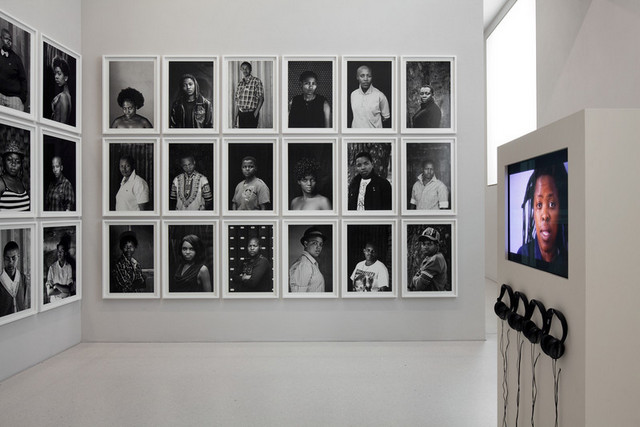
Credit Anders Sune Berg
Luckily, right now we can all enjoy some of Muholi’s work for free on IMDB. Her film Difficult Love is being streamed in full and for free. (Film trigger warning for discussion of rape and queerphobia.)
Directed by Muholi and Peter Golsmid, Difficult Love provides a glimpse into Muholi’s life and the lives, loves, and struggles of other black lesbians in South Africa. Muholi introduces us to a fraction of the stories and people that have moved her to create images that speak of something other than heterosexism, images that speak about us and the multitude of identities that a woman’s body can hold.
It is a powerful, at times difficult film to watch, but I’d recommend you watch the film soon, because Sistah Sinema and Elixher will be holding a live video chat about it with Muholi herself this Sunday, December 16th at 5pm PST/8pm EST. It’ll be broadcasting on YouTube, so keep an eye on Elixher’s Facebook page for the link to jump in. I know I’ll be doing a fair amount of Facebook watching that day.
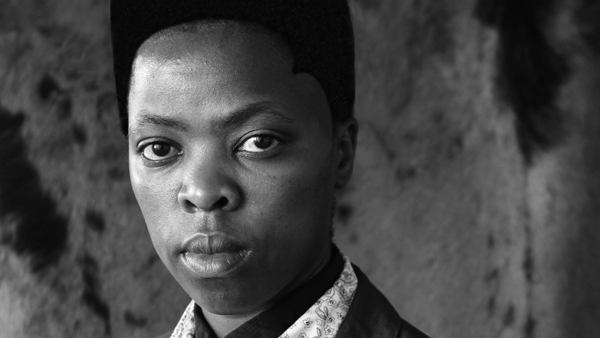
Zanele Muholi
Muholi is an inspiring figure that brings visibility to black queer identity in Africa in a manner that is self-aware and intentional in its rejection of the long imposed binaries resulting from colonialism. Check out more of her work and tune in on Sunday. Anyone who is interested in intersectionality, anti-colonialism, and just regular rattling of the cage of mainstream norms, this is for you.







